“It often seems to me,” said Sathya, “that we are looking for things that are not visible.”
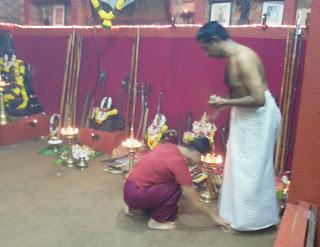
touching the gurrukal's feet and receiving his blessing at Navaratri
Sathya is Sri. G. Sathyanarayanan Gurukkal of the CVN Kalari Sangham, East Fort, Trivandrum.Trivandrum (Thiruvananthapuram, but everything is longer in Malayalam) is the capital of Kerala, the southwestern state of India known as “God’s own country,” which takes its name from the coconut trees that grow everywhere.The people here speak Malayalam, the Indian language with the longest alphabet, as it apparently encompasses all sounds possible both in Sanskrit from the north of India and the southern, aboriginal, Dravidian languages.
Sathya’s father was invited to establish a kalari in the city when Trivandrum became the capital of the newly-formed state of Kerala in the 1950s.The local maharaja, a great patron of the arts, felt the new capital should have a representative of this ancient Keralan art-form which actually hails from a more northern part of Kerala (Sathya’s kalari lineage being of the “northern style”) and so enticed Sathya’s father south.Sathya’s father’s father is, as far as I understand, where the “CVN” initials come from.He and his guru (along with a few others) are credited with reviving the south Indian martial art, kalarippayattu, at a time when it was in danger of dying out entirely.
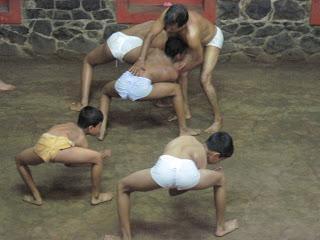
Rajan adjusts the boys in morning training
So here I was, for the second time, to my great delight (and continuing gratitude to the Arts Council of Wales for my training grant).Last time I was here for a month, in February 2010; this time it was to be four.I was again staying in the house Rajan rents to (mostly foreign) kalari students, Rajan being the main instructor at the kalari, as Sathya these days is very busy with the clinic.
“You are bigger,” said Rajan to me by way of greeting, as I got out the taxi from the airport, way back in September.I’m not sure that I was, but either way, I was soon to get smaller.
So for anyone who wasn’t following my blog last time round, kalari is the martial art native to Kerala, whose practice, I think, also extended into parts of Tamil Nadu and Karnataka.At any rate, it is definitely south Indian and is now most associated with Kerala.According to legend, it is the martial art the Buddhist monk Boddhidharma took with him up to China and taught at the Shaolin Temple.As such, some people claim it is the father of kung-fu and so of all other Asian martial arts.Whatever its progeny, kalari is very old.
Along with the martial art, kalari evolved a healing system, derived from Ayurveda (the traditional Indian medicine) but more specialised to deal with neuromuscular and skeletal issues.Essentially, they worked out how to heal injuries sustained during training and combat.Sathya refers to it as “traditional sports medicine.”
So the word “kalari” refers to the building we practice in, the martial art itself, and the healing system.The CVN Kalari in Trivandrum houses the kalari, set traditionally partly underground, the clinic, and a whole series of back rooms where oils and medicines are made (though now there is a nice new factory, a little out of town, to make the medicines more efficiently, still mostly by hand).
I think I described the atmosphere of the kalari fairly fully last time round. Here’s the link, if you’re curious.
And the CVN Kalari website here has some excellent information for anyone interested.

boys practicing the salutation
So what are we looking for that is not visible?
During the first week or so of my visit, Sathya had asked me to describe my interest in kalari.I am getting a little better at doing this as I’ve had a fair bit of practice in the last couple of years, and so I explained that I was investigating the relationship between martial arts, yoga and dance-making, from the point of view of the states they create in the body.How do we draw on those in a more systematic way?And how do we share them?
“So it is more as a body-mind system,” said Sathya.“That is my interest too.”
The challenge with kalari is that the outer form demands a lot of the body.Unless they start young, have other body training or are naturally flexible and strong, many people’s hips will never go to the positions required.And the outer form has to be to some degree approximated before the inner form can really be accessed.
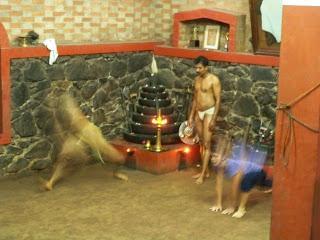
with two very seniors, Peter and Hari
“It is a blessing,” says Rajan, “to have a body that is suitable to kalari.”
But it’s a blessing that demands a lot of work and sweat.
So the legs must kick high and lunge deep and the body must flow through all this with ease.
“Place the body correctly, and just move!Just move!” says Rajan, quite frequently.
Which is beautifully simple and clear.
Unfortunately, setting the body correctly is also beautifully difficult, and moving easefully through those positions when you’re first learning them can seem all but impossible.
“His chest would touch the floor,” said Rajan about his guru, Sathya’s father, describing him moving through a sequence in his seventies.“Such perfection was there.”
Well I have nearly four fewer decades and much less perfection.
So I do what I always try to do in the face of a difficult practice I love.Just show up and do, every morning, six mornings a week (bar the bar on women entering the kalari during menstruation), not worrying where it’s all going, just doing it to do it, to be present with the struggle and curiosity.
Men traditionally wear a langhotti, or loincloth, so don’t have to worry about too much laundry (which I suspect their wives, mothers or cleaning ladies do anyway).We oil ourselves before we practise, to keep the body supple, protect the joints and maintain heat, more commonly with gingelly (sesame) oil, or perhaps with a medicated kalari oil to treat a particular strain or ache.We also oil our heads with a coconut-based kalari head-oil “to prevent too much sweating”, says Sathya. I can’t say I’ve noticed much diminution of sweat, but I usually apply it regardless.The kalari floor is packed earth and the kalari itself is built to be protected from drafts and yet is cooler than the outside temperature.Nonetheless, we sweat a lot, and with that and the oil, the earth we touch, lie on, crouch into, collects on us.The men just need a quick shower after practicing. For we women, it’s rather more complicated and I frequently ring out earthy, oily clothes, as wet with sweat as they would be had they been dipped in the bucket I later wash them in.
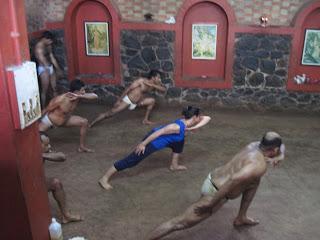
illustrating the clothing contrast with the beginning of the salutation
I suppose it’s no wonder I’ve got smaller.
And no wonder that most of my clothes are wrecked and shall be ceremoniously burnt before I leave (we have no rubbish collection here).
And as we foreign women (there were four of us, now three) don’t have wives, mothers or cleaning ladies who do our laundry, we daily bucket-wash our kalari clothes, a work-out in itself.
A month after I arrived, we were into Navaratri, the festival of nine nights dedicated to the three major manifestations of the goddess. It begins with three nights to Durga, warrior goddess and patroness of kalari and body-practices.Then comes Lakshmi, goddess of abundance and worldly joy.The final three nights are for Saraswati, goddess of learning, the arts, the Vedas, speech.These last three nights to Saraswati mark the annual kalari puja (religious ceremony), which also goes on for three days.
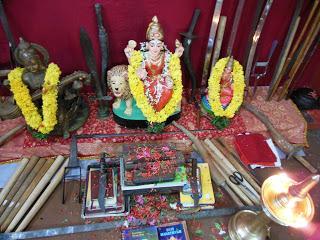
Durga, flanked by Saraswati and Lakshmi, plus all our books and the 300+ year-old palm-leaf kalari manuscripts, all there for blessings
In the days leading up to the puja, training was cancelled and people trooped from near and far, old students returning for the first time in many months to their kalari, to clean, polish, oil, paint, decorate the whole place.Everyone mucked in, from the gurukkal to the boys. As Rajan explained, it is the students’ privilege to care for the kalari.
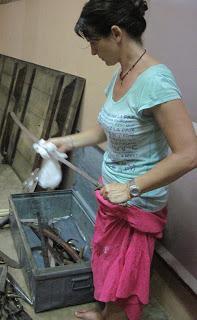
cleaning the historical weapons
The three days of puja were both moving and humbling.On the first night, the goddess is invoked by the Brahmins who had come specially from the huge Padmanabhaswamy Temple in Trivandrum (the one that won’t let me in because I’m not Hindu).Sathya explained they were from a Tantric lineage from Gokarna in Karnataka and that the first puja was to bring Shakti into the kalari (which is also a temple).
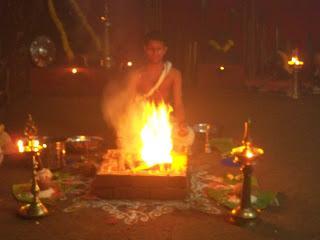
The Brahmin performs the Ganapatty Homa.
The second morning, I arrived at the kalari at 5:00 to see the preparations for the Ganapatty Homa, the fire offering for Ganesha, the elephant god, remover of obstacles, son of the goddess.That evening was the “big” puja, and much of the afternoon was spent adding more flowers to the idols and portraits, preparing the prasad (blessed food offering) for everyone to take back at the end of the cermonies that evening. And the kalari was packed.
I spent the best part of 15 hours in it that day.
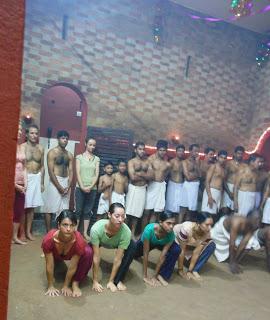
All students perform something as training resumes. For most of us, it was the first leg exercise.
The kalari was possibly even more packed the next morning, for the puja that saw training start once again. This is what I wrote to a friend, shortly after:
The ceremonious recommencement of training today was quite special, loads of us in the kalari, slightly nerve-wracking in that it felt a bit like a performance but with no real idea what I was supposed to do. A whole load of new students watched patiently from the gallery for a couple of hours or so until they were brought down and initiated.
It's been very special to be at the kalari over the puja. It's a bit like Christmas, helping with all the cleaning and preparations. The pujas themselves were beautiful and Sathyan has been very kind about explaining things to me, because he knows I'm interested. You put work material by the goddess at the beginning of the 3 days, so my Sanskrit and kalari notebooks got 3 days of blessings. Then this morning, we all wrote a line in front of the goddess, a Ganesha mantra, for new beginnings, and then we all started. There's such devotion in the kalari, to the practice, to the teachers, to God. It manifests in private and public ways, but mostly very practical ones. Everyone was so willing and wanting to work and help and serve. Both Sathyan and Rajan did full prostrations this morning. There was something very moving about all of it. I know I'm incredibly lucky to have the privilege of learning from these people.
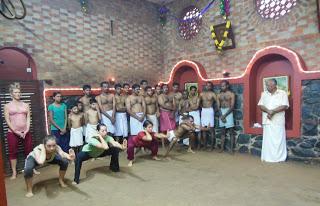
the opening of the first sequence
As part of the final puja, all the students line up, present a betel leaf, nut and symbolic coin to the gurukkal and touch his feet while he blesses them.This touching of the gurukkal’s feet used to happen on a daily basis, but Sathya said to me his father stopped it, not deeming it so appropriate in a modern context and unhappy with people who barely knew him coming to touch his feet.So Navaratri is about the only time it happens now, but it’s symbolic of something Sathya was later to explain to me as crucial to the practice of kalari.
“It is important that kalari happens in a small, spiritual place, removed from the outside world.When the student enters and touches the floor, he is submitting his ego.”
The kalari is a space where the mind must undergo a change.In touching the feet of the master, we dispel negative energy, as he removes it in blessing the student by touching his head and praying for him.
We daily remind ourselves of this submission as we pay our respects to the ground itself on entering the kalari, to the puttara, the main Shiva-Shakti deity, and then the eleven other representatives of gods and gurus around the kalari before we begin any body practice, and again with each and any weapon we take up.It is this humility, in large part, which prepares the mind to undergo the changes necessary to allow and perceive subtle changes in the body.
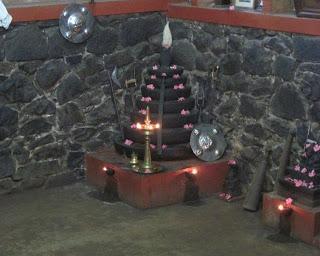
the puttara, dedicated to Shiva-Shakti
I’m not sure Sathya would agree, but I sometimes see the physical training of kalari itself as a form of tapas, heat-generating austerity that burns karma and produces inner change.
“Try and feel some small air or wind here,” said Rajan once or twice, adjusting my elephant posture and placing a finger on a point low on my spine.
In my first few weeks, Sathya was experimenting with teaching kalari concepts in a different manner to the traditional training where not much is said and the practitioner learns through repetition over years.Sathya was articulating and breaking down concepts in a way never done in traditional kalari teaching.
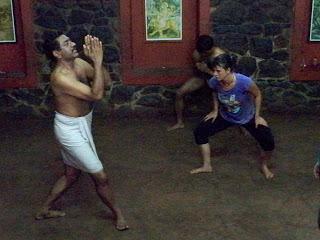
working to emulate the co-ordinations Sathya illustrates so clearly
So movement must come from the naabi mula, a point I had never heard of before.It’s not the hara, or the muladhara cakra or “the centre”, as these are generally seen as areas in the body.The naabi mula is a point within the muladhara, from which vayu, the subtle wind, air, breath, powers movement. A skilled kalari practitioner is one who controls his center and whose movement stems from the naabi mula. At this point, his vayu will be good and effort will be minimal.But the body has to be very flexible and strong to get to the place where the spine can move freely and openly through those low, low crouches and high leaps.
There is a series of pictures in the clinic from an advert Sathya featured in for a Japanese energy drink in 1987.The pictures are of his truly extraordinary leaps.
“I do not think there will be another one like Sathyan-Sir for many years,” mused Sujith one day, who treats people in the clinic.I hadn’t thought of it that way before, but no, I doubt there will be.
The more Sathya talks about it, the stronger is the image for me of the spine like a snake rising up from the naabi mula, sinuous and strong in its freedom.This relates for me to my sense of kalari raising Shakti, primordial, creative energy, and the Nagadevi (serpent god) next to the puttara in the kalari.
The reason I’ve had such a wealth of information from Sathya, who is only sporadically with us training in the kalari these days, is that I have also been learning kalari chikitsa (massage treatment) from him, as well as starting an experimental documentation project, which has involved lots of asking of questions. More on that in future blogs.
In the meantime, the theory was clear, the images were beautiful, but my exhausted, aching body wasn’t having it.The heel is a major focus of the foot in kalari; all turns happen on it, and the bottom of mine were shredding on the kalari floor.Everything else mostly felt heavy and tired.
Slowly, my stamina increased, my heels toughened up (they now feel like sandpaper but they no longer shred when I turn), my thighs started to bang my belly when I kicked, the sequences were less exhausting, the jumps became lighter, and I had the sense I could release into the low crouches and still have some spring to come back out of them.I’m still fairly pants at the stick, and try Rajan’s considerable patience with me, but I’m hoping to improve.
A week or so ago I started meditating on the cakras according to their descriptions in the kalari treatment texts. The colours are subtly different to what I had heard before, described more evocatively and with very specific presiding deities.The silver snake I often see wove its way up them and - lo and behold! - I felt my naabi mula and its accompanying wind (vayu) for the first time as a felt physical rather than theoretical sense.
A couple of days ago, during our documentation sessions, Sathya pointed out “When Lucy is practicing now, I see a lightness coming.” This is the change he has been describing.It just so happens I only have a couple of weeks or so practice left to me before I leave, and I’m not entirely sure how I shall continue when I go.
But I don’t want to lose it.
From Lucy, with love, x
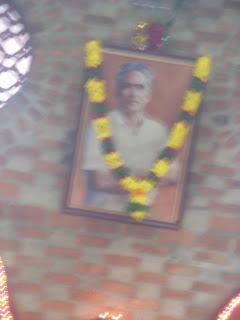
The gurukkal's gurukkal looks on.

